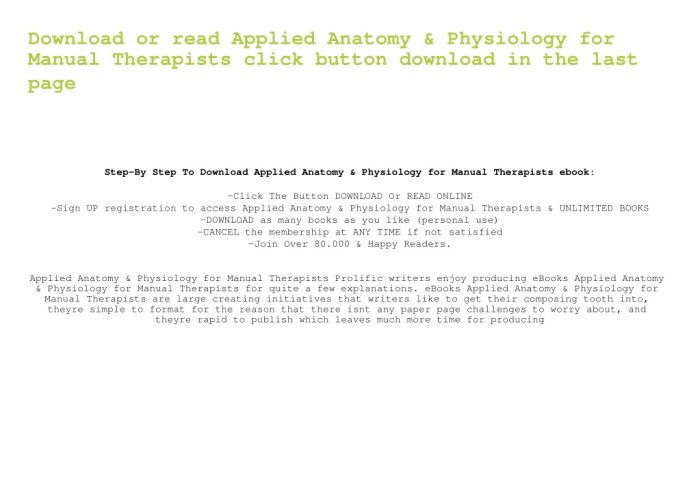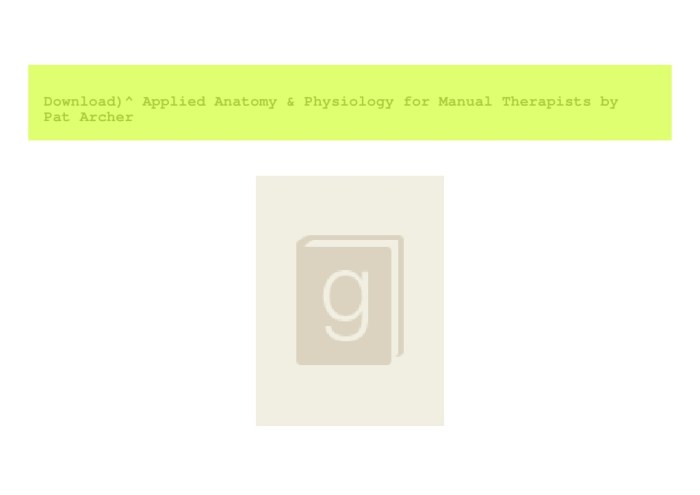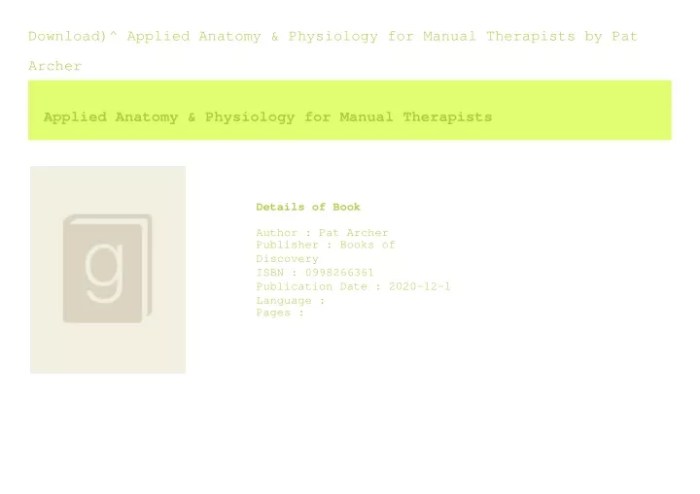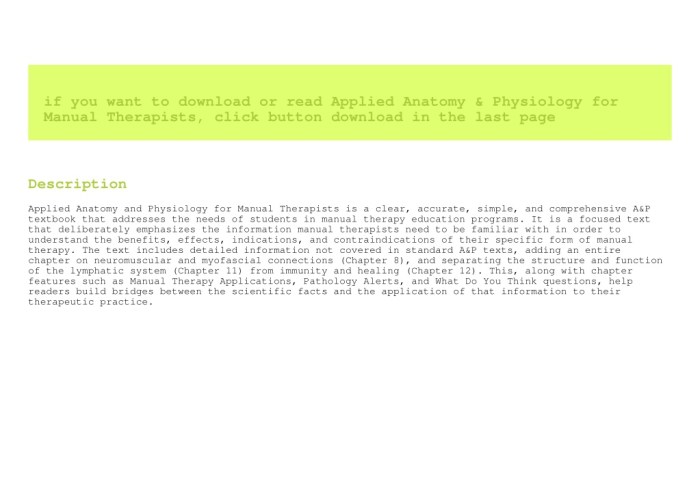Applied anatomy & physiology for manual therapists – Applied anatomy and physiology for manual therapists is a specialized field that combines the study of human anatomy and physiology with the practical application of manual therapy techniques. Understanding the intricate relationship between these disciplines is paramount for manual therapists to effectively assess, diagnose, and treat musculoskeletal conditions.
This comprehensive guide delves into the anatomical structures, physiological processes, and biomechanical principles that underpin manual therapy practice. By gaining a thorough understanding of these concepts, manual therapists can enhance their clinical decision-making, improve treatment outcomes, and optimize patient care.
Understanding Applied Anatomy & Physiology for Manual Therapists

Applied anatomy and physiology provide manual therapists with a comprehensive understanding of the human body, enabling them to assess and treat musculoskeletal conditions effectively.
Explain the relationship between anatomy and physiology in manual therapy.
Anatomy describes the physical structures of the body, while physiology explains how these structures function. Manual therapists utilize this knowledge to understand the biomechanics of movement, assess musculoskeletal dysfunctions, and develop targeted treatment plans.
Discuss the importance of understanding the musculoskeletal system for manual therapists.
The musculoskeletal system, comprising muscles, bones, and joints, is the primary target of manual therapy. Understanding its anatomy and physiology allows therapists to identify and address imbalances, restrictions, and pain in these structures.
Provide examples of how applied anatomy and physiology guide manual therapy techniques.
Manual therapists use applied anatomy and physiology to guide techniques such as joint mobilization, soft tissue mobilization, and stretching. By understanding the anatomical structures involved, they can apply appropriate force and leverage to restore mobility and reduce pain.
Musculoskeletal Anatomy for Manual Therapists: Applied Anatomy & Physiology For Manual Therapists

Create a table outlining the major muscles, bones, and joints involved in manual therapy.
| Muscle | Bone | Joint |
|---|---|---|
| Gluteus maximus | Femur | Hip joint |
| Quadriceps femoris | Patella | Knee joint |
| Trapezius | Clavicle | Acromioclavicular joint |
Include illustrations to demonstrate the anatomical structures and their relationships., Applied anatomy & physiology for manual therapists
[Insert illustration of the musculoskeletal system]
Explain the functional significance of each structure in the context of manual therapy.
Each muscle, bone, and joint plays a specific role in movement and stability. Manual therapists target these structures to improve mobility, reduce pain, and restore function.
Neurological Anatomy for Manual Therapists

Describe the nervous system and its role in movement and sensation.
The nervous system controls movement, sensation, and coordination. Manual therapists understand the neuroanatomy to assess neurological function, identify dysfunctions, and facilitate recovery.
Discuss the impact of neurological dysfunction on manual therapy interventions.
Neurological dysfunction can affect muscle function, sensation, and coordination, impacting the effectiveness of manual therapy techniques. Manual therapists consider neurological factors when assessing and treating patients.
Provide examples of neurological assessments used in manual therapy.
Manual therapists use neurological assessments such as muscle strength testing, sensation testing, and coordination tests to evaluate neurological function and guide treatment.
Key Questions Answered
What is the significance of applied anatomy and physiology in manual therapy?
Applied anatomy and physiology provide manual therapists with a deep understanding of the human body, enabling them to accurately assess and treat musculoskeletal conditions. This knowledge guides their treatment decisions, ensuring the safety and effectiveness of their interventions.
How does applied anatomy and physiology contribute to pain management?
Understanding the physiological mechanisms of pain and inflammation allows manual therapists to develop targeted treatment strategies that effectively alleviate pain and promote healing. Manual therapy techniques can modulate pain signals, reduce inflammation, and restore tissue function.
What role does biomechanics play in manual therapy?
Biomechanics provides manual therapists with insights into the mechanics of movement and the forces acting on the body. By analyzing biomechanical imbalances, manual therapists can identify and address dysfunctions that contribute to musculoskeletal pain and dysfunction.
